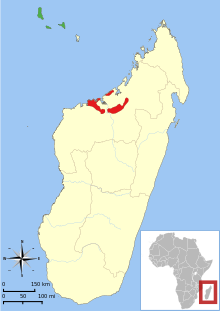Mongoose lemur
| Mongoose lemur | |
|---|---|

| |
| Mongoose lemur at Cleveland Metroparks Zoo | |
| Scientific classification | |
| Domain: | Eukaryota |
| Kingdom: | Animalia |
| Phylum: | Chordata |
| Class: | Mammalia |
| Order: | Primates |
| Suborder: | Strepsirrhini |
| Family: | Lemuridae |
| Genus: | Eulemur |
| Species: | E. mongoz
|
| Binomial name | |
| Eulemur mongoz | |

| |
| Distribution of E. mongoz:[1]red = native, green = introduced | |
| Synonyms | |
| |
The mongoose lemur (Eulemur mongoz) is a small
Description
The mongoose lemur ranges in size from 12 to 18 in (300 to 460 mm) long plus a tail of 16 to 25 in (410 to 640 mm). Both sexes are born with white beards, but become obviously dimorphic around six weeks of age when the males develop red beards and red cheeks. The males also have lighter faces than the females.[4] Males may further distinguish themselves when scent-marking territory, as they occasionally develop a bald patch on top of their heads from rubbing.[5]

Distribution
The mongoose lemur lives in dry deciduous forests on the island of Madagascar and in the humid forests on the islands of the Comoros. This makes the mongoose lemur one of only two lemurs found outside of Madagascar,[4] though it is an introduced species in the Comoros.[6][7]
Ecology
The mongoose lemur mostly eats fruit, though flowers, leaves, and nectar also make up part of its diet; (they may use the nectar of the non-native kapok tree,
Mongoose lemurs are
Mongoose lemurs have seasonal habits. Their breeding, eating, and activity habits are largely shaped around the season. Seasonal fluctuations in food resource availability describe the behavior of mongoose lemurs such as female dominance and small group size. Mongoose lemurs usually conceive their offspring some time during October. They present as Nocturnal during the dry season and diurnal during the wet season.[11]
Status
Captive mongoose lemurs can live up to 26 years, while wild specimens live 18–20 years.[5] Mongoose lemurs in the wild are threatened by the destruction and fragmentation of the forests in which they live, and also by hunting. Their numbers have dwindled by about 80% over a period of 25 years, and the International Union for Conservation of Nature has rated their conservation status as "critically endangered".[1] Mongoose lemurs are more endangered in Madagascar, but there could be a way to conserve them in Comoros because of the increase of these species' population in the area. People should continue to work together and protect these critically endangered species.[12]
Notes
References
- ^ . Retrieved 19 November 2021.
- ^ "Checklist of CITES Species". CITES. UNEP-WCMC. Retrieved 18 March 2015.
- OCLC 62265494.
- ^ a b c d e Chicago Zoological Society - Brookfield Zoo's Mongoose Lemur page Archived 2010-07-20 at the Wayback Machine
- ^ a b c d Bristol Zoo - Mongoose Lemur Archived 2010-06-06 at the Wayback Machine
- ^ a b c d "ARKive - Mongoose Lemur (Eulemur mongoz)". Archived from the original on 2009-02-21. Retrieved 2010-07-08.
- PMID 12719521.
- S2CID 237889124.
- PMID 35214854.
- PMID 34679832.
- ^ "Mongoose Lemur". Duke Lemur Center.
- S2CID 86069333.
External links
![]() Data related to Eulemur mongoz (Mongoose Lemur) at Wikispecies
Data related to Eulemur mongoz (Mongoose Lemur) at Wikispecies
- Animalinfo.org: Mongoose lemur
- Rogerwilliamsparkzoo.org: Mongoose lemur
- mongoose-lemur/eulemur-mongoz Mongoose lemur media from ARKive
- Duke Lemur Center A research, conservation, and education facility
- Lemur Conservation Foundation A research, conservation, and education facility

